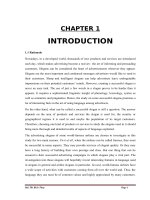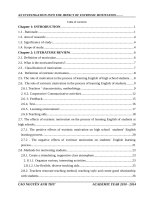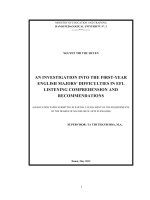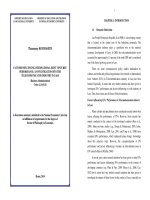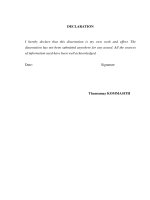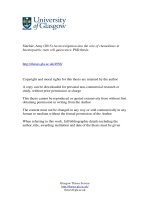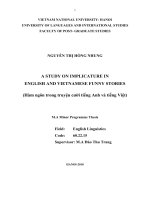AN INVESTIGATION INTO THE SENTENCE PATTERNS USED IN TRAVEL ADVERTISEMENTS ON ENGLISH AND VIETNAMESE WEBSITES
Bạn đang xem bản rút gọn của tài liệu. Xem và tải ngay bản đầy đủ của tài liệu tại đây (280.54 KB, 45 trang )
1
INTRODUCTION
1. Rationale
Advertising is a device to arouse consumers' attention to a commodity and induce them to
use it. In the increasingly keen competition of the market economy, advertising is an
important means of scrambling for markets. According to the American Marketing
Association, Chicago, "Advertising is any paid form of non personal presentation of ideas,
goods and services by an identified sponsor."
Advertising is as ubiquitous as the air we breathe. Advertising has become the part and
parcel of present-day life. From everywhere around us, advertisements of diverse types come
naturally to our life. In spite of it, there is an attractive power, which is able to manipulate
the consumer; an invisible voice of advertisement advocates, encourages, asks, announces
and deeply embeds into peoples’ minds. Advertising unifies language, pictures, music; it
contains information, invokes emotions and imaginations, it can capture all five human
senses.
In order to enhance the appeal of an advertisement, advertising writers pay much attention
not only to such expressive devices as plates, color and the layout of a printed page, but also
to the choice of words or phrases or sentences, to make an advertisement beautiful and
attractive. In the practice of the advertising, people pay more and more attention to the use of
figures of speech with every effort to make the advertising succinct, accurate and vivid and
to provide rich imagination and plentiful associations for readers so as to stimulate their
desire.
In terms of advertising language, advertising texts are of great value for the analyses from
marketing experts, sociologist, etc. and last but not least linguists. Sociologists may be
interested in the fact, how advertising influences the values, attitudes and behavior of the
society. And marketing experts and advertising agencies are interested in the language of
advertising to find the tricks how to make advertising more effective. On the other hand,
linguists are interested in language of advertising because they want to know how particular
language works in this type of discourse, which linguistic means are used here and how
advertising language is changing in the course time.
2
I have no ambition to make an analysis of language of adverting from all aspects such as
phonological, lexical and morphological, syntactic and semantic aspect. Within the scope of
my study in this thesis, I only focus on the sentence patterns used in advertisements. AN
INVESTIGATION
INTO
THE
SENTENCE
PATTERNS
USED
IN
TRAVLE
ADVERTISEMENTS ON ENGLISH AND VIETNAMESE WEBSITES is the study of
what kinds of sentences are presented in the mass media – websites.
2. Aims of the study
In this thesis, the hypothesis and the research questions are:
-
What are the features of travel advertising sentences used in English and Vietnamese
websites?
-
To what extent are the identified characteristic features similar and different between
English and Vietnamese? Are they due to the social and cultural influences on the
advertisement writers?
-
What suggestions should be noted for teaching and learning about travel
advertisements?
3. Research methods and process of research
In order to demonstrate the features of sentence patterns used on website advertisements, I
combine qualitative and quantitative analysis. According to Nunan (1992) (adapted from
Richard and Cook, 1979), a qualitative research is a naturalistic and uncontrolled
observation, subjective, grounded, discovery-oriented, exploratory, descriptive and inductive
(p. 4). Maykut and Morehouse (1994) define qualitative research as generally examining
people’s words and actions in narrative or descriptive ways more closely representing the
situation as experienced by the participants. The aim of qualitative research is to discover
meanings that emerge after close observation, careful documentation, and thoughtful
analysis.
The qualitative method is used to gather data. The data are then analyzed both qualitatively
and quantitatively in terms of the mean length. When studying the features of sentence
patterns used, as a result of quantification, we can look for recurring patterns emerging from
the data.
3
First I collect data for study from the internet, including advertisements written in English
and those written in Vietnamese. The two sources then are to be investigated from a cross –
linguistic perspective to study the similarities and differences between the sentence patterns
of the two languages.
On the ground of the findings in this stage of investigation, the texts in advertisements are
randomly chosen and closely analyzed to serve the goals and aims of the study.
4. Scope of the study
The study deals with sentence patterns used in travel advertisements on English and
Vietnamese websites. The data for the study consists of texts from advertisements on English
and Vietnamese websites. My areas of interest are the passages advertising specific tourist
attractions in cities. The travel advertisements selected here are, therefore, about different
places in some foreign countries and Vietnam.
Due to a shortage of time and within the limitation of an M.A thesis, the study only focuses
on the analysis and comparison of 10 travel advertisements in each language.
5. Design of the study
The introduction of the study is aimed to give the background of the study. It mentions the
rationale, aims of the study, the research methods, scope of the study and the process of
research.
The development part of the thesis consists of three chapters:
Chapter 1 deals with theoretical background, giving sentence definitions, functions of
sentences and discourse of advertising.
Chapter 2 presents the sentence patterns used in English and Vietnamese advertisements
including sentence types and sentence structure.
Chapter 3 discusses the similar and different features in sentence patterns of the two
languages in travel advertisements and implications for teaching and learning about travel
advertisements.
The conclusion works out with some findings and suggestions from the research.
4
CHAPTER 1
THEORETICAL BACKGROUND
1.1. What is a sentence?
1.1.1. Definitions
There is a variety of definitions of a sentence. McDougal Littell (2004) simply defines a
sentence is a group of words that conveys a complete thought (p. 36). Brown, Nilson, Shaw
& Weldon (1984) share the same and add some more information: “a sentence is a group of
words that expresses a complete thought. The purpose of a sentence is to describe an action
or state a condition of a person, a place, a thing or an idea.” (p. 57)
Halliday (1994) argues that “describing a sentence as a construction of words is rather like
describing a house as a construction of bricks, without recognizing the walls and the rooms
as intermediate structural units.” (p. 180). He states that a sentence should be defined as a
clause complex with the simple sentence (one clause) as the limiting case.
Morley (2000, p.25) looks at a sentence in many aspects. In meaning terms, he says “the role
of the sentence is to express one or more ideas or ‘proposition’ from the ideational
component, each proposition being realized by a clause.”
Nguyễn Hòa (2001) says “…the sentence refers to the system or language side: it can be
thought of as the ideal structure behind various realizations in utterances.” (p. 23)
Mai Ngọc Chừ, Vũ Đức Nghiệu & Hoàng Trọng Phiến (2006) give out the definition about a
sentence: “câu là đơn vị của ngơn ngữ có cấu tạo ngữ pháp (bên trong và bên ngồi) tự lập
và có ngữ điệu kết thúc, mang một tư tưởng tương đối trọn vẹn có kèm thái độ của người
nói hoặc chỉ biểu thị thái độ của người nói, giúp hình thành và biểu hiện, truyền đạt tư
tưởng, tình cảm với tư cách là đơn vị thông báo nhỏ nhất.” (p. 285)
(A sentence is the language unit which has independent inner and outer grammatical
structure and ending intonation. It bears a relatively complete thought enclosed with the
speaker’s attitude or only displaying the speaker’s attitude, which helps form, show and
communicate ideas and affection as the smallest information unit.)
I myself like and follow the definition of Richards and Platt (1992) about a sentence: “the
largest unit of grammatical organization within with parts of speech (e.g. nouns, verbs,
5
adverbs) and grammatical classes (e.g. word, phrase, clause) are said to function. In English
a sentence normally contains one independent clause (…) with a finite verb.” (p. 330).
From that we can conclude that a sentence must make complete sense by itself.
Thus, “The mobile phone on the table” is not a sentence as it does not express a complete
thought. The correct one can be “The mobile phone on the table belongs to my father.”
1.1.2. Functions of the sentence
In language usage, Diệp Quang Ban (2004) lists three major functions of the sentence:
expressive function, interpersonal function and text-making function.
(1) Expressive function: in daily communication, one by some means or other expresses
one or some events in his experience. This can be done thanks to the fact that
language has a mean compatible with it which is called “the sentence in expressive
function” (p.27). Those events in experience are not in fixed forms; they are
expressed through one’s viewpoint and coded in grammar of a certain language.
Therefore, the same event can be viewed and expressed in different ways in different
languages and even different in one language due to different expressions.
(2) Interpersonal function: in conversations, people use sentences to communicate with
one another. In that process, the speaker always intends to do some action to
influence the hearer. For example, the speaker speaks to inform about something, to
ask the hearer to do something, to express his thought to the hearer or to set up a
communication relation. Those actions are called speech actions. In each language
system, there are means that mark those speech actions, such as declarative,
interrogative, imperative and exclamatory sentences. (p 29 – 30)
(3) Text-making function: in a certain situation, the sentences must be organized to be
in harmony with the preceding and following ones (in other words, co-text) or with
the outside situation (context of situation). In this case, sentences are regarded as a
message. The organization of the sentences to make a message requires two
elements: Theme and Rheme. The relation of these two elements is called Theme –
Rheme structure. (p. 30 – 31)
1.2. Discourse of advertising
1.2.1. The concept of advertising
6
The concept of advertising dates back to early civilization. Approximately, in 3,000 B.C,
Babylonian merchants knew to place signs over their doorway to indicate what they sold. In
ancient Greece and Rome, advertisements were found on walls in the streets. Advertising
today began in 19th century and developed with industrialization and mass production.
In this part of the study, I would like to give an idea what advertising is, and which types of
advertising exist. This will bring the general and basic definitions necessary for
understanding the issue as a whole.
1.2.1.1. Definitions of advertising
“Advertising is a one-way communication whose purpose is to inform potential customers
about
products
and
services
and
how
to
obtain
them.”
( />Michael, on defines advertising is “Making known;
calling public attention to a product, service, or company by means of paid announcements
so as to affect perception or arouse consumer desire to make a purchase or take a particular
action.” and advertisement is “A paid public announcement appearing in the media.”
The American Heritage Dictionary says that the advertising is:
(1). “The activity of attracting public attention to a product or business, as by paid
announcements in the print, broadcast, or electronic media.
(2).The business of designing and writing advertisements.
(3). Advertisements considered as a group: This paper takes no advertising.”
Another definition of advertising is according to the Investorwords glossary: “Description or
presentation of a product, idea, or organization, in order to induce individuals to buy,
support, or approve of it.” ( />Lý Tùng Hiếu in the book Quảng cáo và ngôn ngữ quảng cáo (2004) gives out his definition
of advertising after analyzing other definitions of advertising as follows: “Quảng cáo là hoạt
động của các cá nhân hoặc các tổ chức sản xuất và dịch vụ, sử dụng các phương tiện và
phương thức truyền thông để thông báo cho công chúng về nhu cầu, khả năng của mình hoặc
về lợi ích của những hàng hóa và dịch vụ nhất định nhằm gia tăng số lượng người tiêu dùng,
sử dụng các dịch vụ và hàng hóa đó.” (p. 26)
(It can be temporarily translated as Advertising is the activity of individuals or organizations
of manufacturing and services, using modes and means of communications to inform the
7
publics about their demands and ability or the benefits of given goods and services in order
to increase the number of consumers using those goods and services)
All these definitions have in common the fact that advertising is a means of promotion of a
product, an idea, or an organization on the market with the aim to give information and/ or to
persuade people of the advantage of the product and induce them to take and action (e.g. buy
to use it).
Goddard (1998, p. 10) suggests that “advertising is not just about the commercial promotion
of branded products, but can also encompass the idea of texts whose intention is to enhance
the image of an individual, group or organization.” This suggestion gives out a full
description of advertising, helping give out types of advertising as in the following.
1.2.1.2. Types of advertising
According to Leech (1972), most frequent and important type of the advertising is
“commercial consumer advertising: advertising directed towards a mass audience with the
aim of promoting sales of a commercial product or service…”
E.g: “Plump it up. New volume boost liquid lip colour. Paints lips with a high shine lacquer
finish. Feel the tingling sensation as formula begins to work.”
Another type of commercial advertising is ‘prestige advertising’. Here the name and the
positive image of the company are advertised rather than a product or a service.
E.g: “The America’s Cup: the oldest and most coveted trophy in the world of sailing. Its
organizers have entrusted once again the vital timing of the races to Omega, a company
whose experience in watchmaking and sports timekeeping dates back over 150 years…to the
very origins of the America’s Cup itself.”
As an example of non-commercial advertising, we may mention appeals from associations
and societies whether their purposes are charity or political propaganda:
“Thanks to the World Food Programme, this little girl in Mozambique knows she won’t go
hungry today.”
Vietnamese researchers also give out many ways to classify advertising. Lý Tùng Hiếu
(2004) classifies advertising into 34 minor types according to four criteria: technique, target
audience, morality and legality. (p. 40 – 51)
Mai Xuân Huy (2005, p. 40 - 47)) collects ideas from many researchers to give out seven
ways or criteria of classifying advertising as follows:
8
(1) Basing on medium criterion, advertising types include print advertising (newspaper,
magazines), broadcast advertising (radio, television), out-of-home advertising
(outdoor and transit), and direct mail advertising.
(2) Geographic area criterion: international advertising, national advertising, regional
advertising and local advertising.
(3) Target audience criterion: consumer advertising, and business advertising.
(4) Consumer response criterion: action advertising and awareness advertising.
(5) Purpose criterion: commercial advertising, and noncommercial advertising.
(6) Layout criterion: display advertising, classified advertising, and noticed advertising.
(7) Promoted object criterion: product advertising and nonproduct advertising (or
institutional advertising/ corporate advertising/ prestige advertising)
1.2.2. Advertising - a kind of communication
According to Widdowson (1996), human language “serves as a means of cognition and
communication: it enables us to think for ourselves and to cooperate with other people in our
community.” (p. 3). Nguyễn Văn Khang (1999) discusses the participants in the
communication can take up to four roles: an addresser, a speaker, an addressee and a hearer.
Communication is the process by which individuals share information, ideas and attitudes. It
is the process between at least two sides – the addresser (transmitter – speaker or writer) and
the addressee (receiver – listener or reader). Between these two participants, the coded
meaning (information) is transmitted through the communication channel. Each
communication is proceeding in given context or situation.
Wilson & Wilson (1998) give out a very simple communication model as the following:
Message
Source ============> Receiver
Channel
Diagram 1.1: communication model (source: Wilson & Wilson 1998, p. 7)
They argue the source can be called the sender, communicator or encoder; the message is
whatever the source attempts to share with someone else; the channel is the way in which we
send our message: it may be our sense or technological devices, etc. and the receiver can be
9
called the destination, audience or decoder. In mass communication, the receiver is usually a
large audience.
Mai Xuân Huy (2005) cites the communication process of Jakobson (1960) in the book
“Linguistics and Poetics” as follows:
Ngữ cảnh
Người phát ------------------ Thông điệp ------------------- Người nhận
Tiếp xúc
Mã
It can be translated as:
Context
Encoder ------------------ Message ------------------ Decoder
Channel
Code
Diagram 1.2: communication factors (source: Mai Xuân Huy 2005, p.16)
It follows that advertising is a kind of communication between the creator of advertisement
(in fact, the copywriter who substitutes the producer/seller and transfers his ideas into
advertisements), and the consumer.
From this representation we can clearly see that, in case of advertising, the encoder is the
copywriter, and the decoder is the reader, the meaning transmitted is about the product or
more specifically, an attempt to make the reader buy the product, the code (in the case of
press advertising) is language and some sort of visual code, the channel consists of printed
publications, and the context include such features as the reader’s total situation (Does he
have the product already? Can he afford it? etc.), and the publication in which the
advertisement appears.
This shows advertising is a kind of communication with its own principles. The encoder is a
producer – a company that tries to persuade the decoder – a consumer - to buy a product.
The code of the language has to be known by all participants of the communication. The
message communicated by the advertisement does not discuss everything about the product.
It is incomplete because there is no space enough to describe the product into details. The
message only contains what the producer thinks the consumer needs to know. It always
10
contains the name of the product and usually the information how it can benefit the
customer.
Goddard (1998) discusses about the communication of advertising under the idea of narrator
and narratees. She states that the writer is the person who constructs the text in reality (in
advertising texts, the real writers are the copywriters and artists who work in an advertising
agency’s creative department), while the narrator is the storyteller within the text.
Copywriters can “construct all sorts of different narrators to convey to us the message of an
advert” (p.29), for example, a female writer can construct a male narrator, or an adult writer
can construct a child narrator. Narratees are, on the other hand, people who appear to be
addressed. In fact, in advertising communication, a narratee is not a certain person, but at
least a target group, or a whole public.
“The widest address forms to be given to a narratee in an advertisement are no address form
at all (0) or ‘you’. In both these cases, any person reading the advert can feel addressed by it
and not excluded from the communication.” (Goddard 1998, p.31). The widely used pronoun
‘your’ symbolizes the closeness of the product to the consumer.
A narrator might be:
•
The first person singular narrator ‘I’ – a character in the story itself; this kind of text
sounds more personally; the narrator talks to us.
E.g.: “I won a certificate good for a free meal!” (Phan Tường Vân 2004, p. 20)
•
The first person plural narrator ‘We’ – This may evoke the effect the whole company
or association talks to the narratee. It makes a corporate impression.
E.g.: “We bring Olympic energy to your home.”
•
The third person omniscient narrator ‘He’, ‘She’, ‘It’, ‘They’ or ‘0’– it is ‘an
observer’ of events, telling us about actions or product.
E.g.:
“In their eyes, they can tug forever.”
“Stop seeing broken hair everywhere.”
“One just right for you.”
The communication through advertising text is interesting: like the communication through
text on magazines or newspapers, the writers “are in difficulty in addressing a mass
audience. They cannot possibly claim to know the identity of each individual reader, yet they
11
often speak as though they already know the reader, their thoughts, attitudes, likes and
dislikes.” (McLoughlin 2000, p. 67).
12
CHAPTER 2
THE SENTENCE PATTERNS USED IN
TRAVEL ADVERTISEMENTS ON ENGLISH AND
VIETNAMESE WEBSITES
In this chapter, we focus on analyzing sentence patterns used in travel advertisements on
English and Vietnamese websites. It should be noted that advertising on websites is
remarkably different from advertising on television as the latter “generally lies on striking
visual imagery, colour and music to get the audience’s attention and to take advantage of the
connotations of words, images and sounds in a very shot space of time.” (Marshall &
Werndly 2002, p. 36) while the former focuses mainly on words and images to attract mass
audience regardless of how much time it takes.
As for sentences types used both in English and Vietnamese advertisements, we investigate
sentence types from the number and kinds of clauses in a sentence as well as sentence
classification by purpose. Finally, sentences both in English and Vietnamese advertisements
are also analyzed according to the thematic structure under Halliday’s philosophy.
2.1. Sentence patterns used in travel advertisements on English websites
2.1.1. Clauses, clause classification and clause elements
In sentences classified by structure, clauses are an important element. Leech and Svartvik
remark “clauses are the principle structures of which sentences are composed.” (1989, p.211)
According to Quirk and Greenbaum (1973), clause types fall into three main classes
structurally: finite clause, non-finite clause and verbless clause (p. 310).
A finite clause is a clause whose V element is a finite verb phrase.
E.g.: John has visited New York. (p. 310)
A non – finite clause is a clause whose V element is a non – finite verb phrase.
E.g.: For a bridge to co llapse like that is unbelievable. (p. 320)
A verbless clause is a clause containing no V element but otherwise generally analysable in
terms of one or more clause elements.
E.g.: When ripe, these apples will be delicious. (p. 313)
13
And the five units: Subject (S), verb (V), complement (C), object (O) and adverbial (A) are
called elements of clause structure, being defined syntactical and semantic ways (p. 170 –
175) as follows:
2.1.1.1. Clause elements syntactically defined
a. Subject
A subject is normally a noun phrase or a clause with nominal function.
E.g.:
The pretty girl in the corner is Tom’s sister.
That she is still alive is a consolation.
The subject occurs before the verb phrase in declarative, and immediately after the operator
in questions.
E.g.:
A special period will need to be set aside for this operation.
Are computers fairly commonplace today?
However, we can use subject-verb inversion for emphasis.
E.g.:
Here comes the bus.
In went the sun and down came the rain.
A subject also has number and person concord with the verb phrase where applicable.
E.g.:
The party is open to all people in the village.
How they got there is still a mystery.
What were once human dwellings is now nothing but piles of rubble.
b. Object
The object is a noun, noun phrase or clause, or pronoun in sentences with transitive verbs,
which is affected by the action of the verb. There are direct objects (O d) and indirect objects
(Oi).
E.g : They gave him a cake.
Oi
Od
The object often follows the subject and the verb phrase and by the passive transformation, it
assumes the status of the subject.
E.g.: The window was broken by that little boy.
c. Complement
A complement is a noun, an adjective phrase or a clause with nominal function, having a coreferential relation with the subject or object.
14
“The expression that describes the subject in clauses (…) is often called the ‘complement’
of the clause or a ‘subject complement’… In some structures, the object of a verb can have a
complement.” (Swan 1997, p. 127)
E.g.:
You must keep calm.
Cs
He got his shoes and shocks wet.
O
Co
It is a part of the sentence which follows the verb to complete the sentence.
E.g.:
Alice is a ballet dancer.
Cs
Do you call yourself a journalist?
Co
However, in formal speech, the complement can be fronted with nuclear stress and thus to be
given special emphasis.
E.g.:
Mary her name is.
Cs
Disappointment you call it!
Co
d. An adverbial
Adverbials are the most diverse of the clause elements. The adverbial is normally an adverb
phrase, prepositional phrase or adverbial clause. It may also be a noun phrase.
E.g.: The manager is not in.
She left a card for John.
John met Mary John met Mary before she went back to America to study.
She came late this morning.
Adverbial can occur in more than position in the clause. The adverbial follows the subject
and verb. It may also follow the direct object and other predication adjuncts normally appear
at the end of the clause.
E.g.:
He got through the window.
Put your hands off me!
By now, Mary must have been there.
15
He greeted us warmly.
Adverbials are generally optional as they may be added or removed from the clause without
affecting its acceptability and without affecting the relations of structure and meaning in the
rest of the clause.
E.g.:
She kindly sent them a warm greeting.
A_optional
In Vietnam, students are now on summer holiday.
A_optional
A_optional
However, in some clause types, adverbials are obligatory.
E.g.:
Your children are outside. [SVA]
The plane is off the ground. [SVA]
We keep Tom off cigarettes. [SVOdA]
She wants the payment in cash. [SVOdA]
2.1.1.2. Clause elements semantically defined
a. Agentive, affected, recipient, attribute
The most typical semantic role of a subject is agentive; that is, the animate being instigating
or causing the happening denoted by the verb.
E.g.:
Tom greeted the delegation warmly.
She lay in his arms.
Direct object (Od) mostly functions as the affected participants. That means the participant
(animate or inanimate) does not cause the happening denoted by the verb, but is directly
involved in some other way.
E.g.: We laid him on the sofa.
O_affected
The frost has killed my roses.
O_affected
Indirect object (Oi) often functions as the recipient; that is an animate participant being
passively implicated by the happening or state:
E.g.:
I’ll give you the answer.
O_recipient
16
The subject complement (Cs) plays the role of attribute of the subject whether a current or
existing attribute (with stative verbs) or one resulting from the event described by the verb
(with dynamic verbs)
Current attribute:
She looks happy.
It sounds good.
Resulting attribute:
His face turned red.
He became restless.
The object complement (Co) plays the same role.
Current attribute:
I prefer coffee black.
Resulting attribute:
He painted the wall blue.
They made him chairman.
b. Agentive and instrumental subject
Apart from its agentive function, subject frequently has an instrumental role. It expresses the
unwitting material cause of an event:
E.g.:
The cold affects me badly.
With intransitive verbs, the subject also has the affected role.
E.g.:
The bell rang loudly.
The table is shaking.
c. Recipient subject:
E.g.:
I heard it ring, too.
You have got brains.
The subject may also have a recipient role with verbs such as have, own, possess, benefit
(from), as is indicated by the following relation:
E.g.:
Mr. Brown has bought his son a radio.
So now his son possesses the radio.
Such perceptual verbs as see and hear also require a “recipient” subject while look at and
listen to are agentive subjects.
d. Locative, temporal and eventive subjects
The subject may have the function of designating place or time:
E.g.:
The road is swarming with ants. (= Ants are swarming all over the road)
The bus holds thirty people. (Thirty people can sit in the bus)
17
Temporal subjects can usually be replace by “it”, the temporal expression becomes adjunct.
E.g.:
Tomorrow is my birthday. (= It is my birthday tomorrow)
Eventive subjects (with abstract noun heads designating arrangements and activities) differ
from others in permitting intensive complementation with a time adverbial.
E.g.:
The concert is on Tuesday.
e. Empty “it” subject
A subject may lack semantic content altogether, and consist only of the meaningless word
“it”, used especially with climatic predications:
E.g.:
It is raining now.
It is getting dark.
g. Locative and effected object
- Direct object: Apart from the affected object, semantic types of direct object are the
locative object and the effected object.
E.g.:
I climbed the high as light fell short. (Locative object)
We are just passing the Eiffel Tower. (Locative object)
Similar verbs used in this case include turn, leave, reach, surround, penetrate, mount, cross,
climb.
An effected object is one that refers to something which exists only by virtue of the activity
indicated by the verb:
E.g.:
Who is making all that noise?
After that, I paid her a visit every evening.
h. Affected indirect object
There is only one exception to the rule that the indirect object has the role of “recipient”: this
is when give (or related verbs like pay, owe) has an “effected” object as direct object and an
“affected” object as indirect object:
E.g.:
I paid her a visit (“I paid her”)
I gave the door a couple of kicks (“I kicked the door a couples of times”)
Has anyone touched the television today?
Have you dropped your handkerchief, my dear?
2.1.2. Sentences classification by clause patterns
